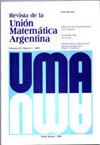波浪贴图到球体
IF 0.5
4区 数学
Q3 MATHEMATICS
引用次数: 0
摘要
在这篇笔记中,我们讨论了Rn上经典调和函数的一些几何类比及其相关的演化。谐波函数在数学中无处不在,在复杂分析、势理论、静电学和热传导中都有应用。R中的调和函数u在一个域Ω中求解拉普拉斯方程∆u = 0,其中∆=∑n j=1∂2 xj。著名的狄利克雷原理说调和函数是狄利克雷能量1 2∫Ω |∇u| 2的临界点。相关的演化是热方程∂tu−∆u = 0和波动方程∂2 tu−∆u = 0。我们将要讨论的几何类比(在物理中也有应用)是调和映射:函数u: R→M,其中M是一个黎曼流形。它们也是狄利克雷能量的临界点,由Eells和Sampson b[15]在20世纪60年代初提出。得到的欧拉-拉格朗日方程是一个非线性偏微分方程,因为非线性约束u(x)∈M。当M = S2与圆度规时,方程变为∆u =−|∇u|2u。引入调和映射的目的是利用它们作为研究流形M的几何和拓扑性质的工具。例如,Eells和Sampson展示了,使用相关的热流(调和图热流),从R到M的平滑函数可以变形(在M上的某些几何条件下)成调和图。这项工作启发了汉密尔顿(Hamilton)提出了他的里奇流(Ricci flow),最终导致佩雷尔曼(Perelman)证明了庞加莱猜想(poincar本文章由计算机程序翻译,如有差异,请以英文原文为准。
Wave maps into the sphere
In this note we discuss some geometric analogs of the classical harmonic functions on Rn and their associated evolutions. Harmonic functions are ubiquitous in mathematics, with applications arising in complex analysis, potential theory, electrostatics, and heat conduction. A harmonic function u in R solves the Laplace equation ∆u = 0 in a domain Ω, where ∆ = ∑n j=1 ∂ 2 xj . The well-known Dirichlet principle says that harmonic functions are critical points of the Dirichlet energy 1 2 ∫ Ω |∇u| 2. The associated evolutions are the heat equation ∂tu − ∆u = 0 and the wave equation ∂2 t u − ∆u = 0. The geometric analogs we will be discussing (which also have applications in physics) are harmonic maps: functions u : R → M , where M is a Riemannian manifold. Introduced in the early 1960s by Eells and Sampson [15], they are also critical points of the Dirichlet energy. The resulting Euler–Lagrange equation is a nonlinear PDE, because of the nonlinear constraint that u(x) ∈M . When M = S2 with the round metric, the equation becomes ∆u = −|∇u|2u. The point of introducing harmonic maps was to use them as a tool to study the geometric and topological properties of the manifold M . For instance, Eells and Sampson showed, using the associated heat flow (the harmonic map heat flow), that smooth functions from R to M can be deformed (under certain geometric conditions on M) into harmonic maps. This work inspired Hamilton [20] to introduce his Ricci flow, which eventually led to the proof of the Poincaré conjecture by Perelman [28]. The study of the singularities of these flows led to the notion of bubbling in singularity formation. It turns out that the bubbling phenomenon is universal, and is analogous to the soliton resolution which we will be considering later. We now turn to wave maps, the wave flow associated with harmonic maps. The topic is vast, and I will concentrate only on aspects close to my interests. There are several ways to define wave maps u : R×R →M . A formal one is to consider the Lagrangian
求助全文
通过发布文献求助,成功后即可免费获取论文全文。
去求助
来源期刊

Revista De La Union Matematica Argentina
MATHEMATICS, APPLIED-MATHEMATICS
CiteScore
0.70
自引率
0.00%
发文量
39
审稿时长
>12 weeks
期刊介绍:
Revista de la Unión Matemática Argentina is an open access journal, free of charge for both authors and readers. We publish original research articles in all areas of pure and applied mathematics.
 求助内容:
求助内容: 应助结果提醒方式:
应助结果提醒方式:


